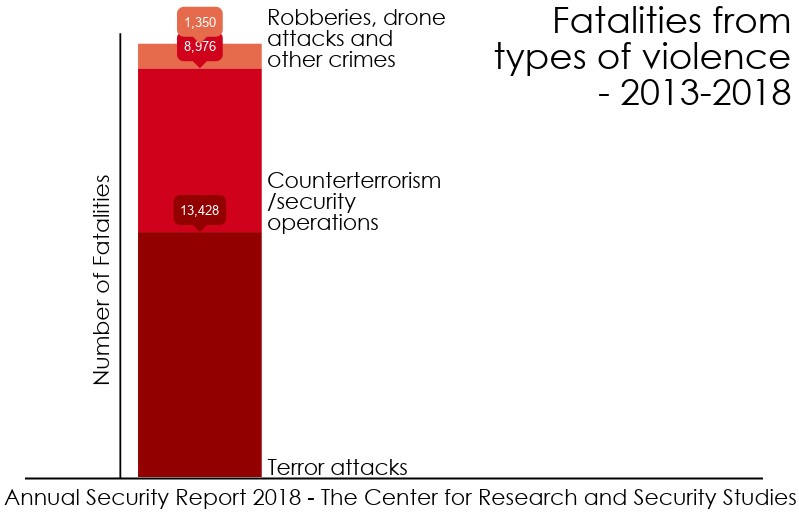
Previous: ASR Main Page | ASR Main Page | Next: ASR 2018 – Introduction
Across Pakistan, and across all metrics, violence-related casualties continued to decline in 2018, registering a 45% drop from the previous year, and a 86% drop since 2013. If we look purely at fatalities from terror attacks and incidents, the number dropped 83% from 4,643 in 2013 to 754 in 2018. This an unprecedented drop in violence across the country. The bulk of the success is owed to the extensive kinetic operations conducted across the country. However, while the progress on eliminating terrorism is exceptional, the progress on eliminating its root cause of extremism remains woeful at best. Ideas germinate are generally bulletproof, and this need serious attention for this improved situation to take hold and become the new norm.

Two major incidents in 2014 precipitated this decline. The first was a brazen attack on Karachi airport in May, 2014. This resulted in Operation Zarb-e-Azb, a military response to rid the tribal region of FATA of militants, the province of Balochistan of insurgents, and the city of Karachi of urban crime. Second, terrorists attacked a school in December, in an incident that would leave a permanent mark on the country, killing 135 children and school staff members. In response, the Pakistan government enacted the National Action Plan (NAP), designed to root out terrorism and extremism from the country. This document and subsequent actions provided further impetus to the ongoing operation, and fueled policy changes aimed at improving security.
Between 2013 and 2018, a total of 23,754 people died from violence-related incidents. Of these, 13, 428 perished in terror/insurgent attacks, 8,976 in counterterror/counterinsurgency operations, and 1,350 from robberies, drone attacks, and other forms of criminal activities. Sindh suffered the highest number of fatalities, and Balochistan the highest number of injuries, despite FATA being the primary theater of militant activity and counterterror operations. Sindh casualties are concentrated in the port city of Karachi by a very large margin; in fact, suicide attack and other forms of terrorism combined is a lower number than the number of target killing conducted by gangs and political militants in the city. Overall there has been a 97% reduction in terror attack deaths in Sindh, 86% in KP, 82% in FATA and 60% in Balochistan.
Broadly speaking, victims can be classified into three categories: civilians, security/government officials and militants/insurgents/criminals. All three groups have witnessed a decline in casualties. However, while the civilians have seen a drop from 72.4% of the total in 2013 to 68.2% in 2018, security officials have seen a steady rise from 14.9% in 2013 to 26.9% in 2018, showcasing the continued sacrificed by the law enforcement agencies. Militants have seen a steady decline as kinetic operations have tightened the noose, dropping from 12.7% in 2013 to 4.9% in 2018.
Purely in terms of kinetics, Pakistan is on a positive trajectory to a secure future, provided the government takes some necessary steps, including strengthening the civilian law enforcement sector, dramatically improving the justice sector and justice delivery, as well as enhanced governance across the board. Pakistan has tremendous momentum and an opportunity to capitalize on its many successes, learn from its many mistakes, and plot a course for a peaceful, prosperous, positive future.
This report is thus divided into five chapters that include terror attacks, counter-terror operations, comparison of terror and counter-terror operations, drone attacks, and sectarian violence.
Readers can approach CRSS for information related to this report. Alternately, you may send your queries to [mail@crss.pk], directly to Mohammad Nafees, Senior Research Fellow, CRSS – the author [mohammad.nafees@yahoo.com], or Zeeshan Salahuddin, Senior Research Fellow and Syeda Uruba Nisar, Social Media Associate – the editors.
Previous: ASR Main Page | ASR Main Page | Next: ASR 2018 – Introduction


